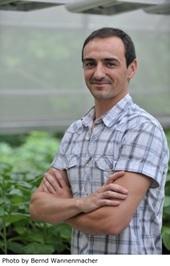Dr. Marco Cosme

Wissenschaftlicher Mitarbeiter
Research interests
The majority of land plants have coevolved for millions of years in association root symbiotic fungi, which facilitate water and nutrient uptake, two of the most essential, often-limiting, factors in crop production. The mycorrhizal fungi are the most common and widespread plant symbiosis, but generally scarce under intensively disturbed soils. Crop domestication, in comparison, is a relatively recent event, beginning only 10 thousand years ago, and the use of intensive practices, brought by the ‘green revolution’, is an invention from the last century. The economic and environmental consequences of intensive practices are now obvious and these strategies from the past aren't meeting the growing food needs, but the key may be buried belowground.
My research goal is to understand the complex functioning of these ancient root symbionts and how they affect yield, quality and resistance of crop plants.
Education
| 2010 | MSc in Forestry and Natural Resources at TU-Lisbon/FU-Berlin |
| 2007 | Dipl in Forestry and Natural Resources at TU-Lisbon (Portugal) |
| 2004 | Exchange student at University of Joensuu (Finland) |
Positions
| 2012 - 2015 | PhD candidate at FU-Berlin |
| 2009 - 2011 | Research assistant at FU-Berlin |
| 2008 | Intern in research at University of Copenhagen (Denmark) |
| 2007 | Forestry advisor at Florasul and Arboris (Portugal) |
| 2005 | Intern in forestry at Swedish University of Agricultural Sciences (Sweden) |
Academic activities
Member of the Deutsche Gesellschaft für allgemeine und angewandte Entomologie (since 2011)
Publications
Peer-reviewed journals
Cosme M, Ramireddy E, Franken P, Schmülling T, Wurst S (in press). Shoot- and root-borne cytokinin influences arbuscular mycorrhizal symbiosis. Mycorrhiza
Cosme M, Lu J, Erb M, Stout M, Franken P, Wurst S (2016, in press) A fungal endophyte helps plants to tolerate root herbivory through changes in gibberellin and jasmonate signaling. New Phytologist
Lu J, Robert CAM, Riemann M, Cosme M, Mène-Saffrané L, Massana J, Stout MJ, Lou Y, Gershenzon J, Erb M (in press) Induced jasmonate signaling leads to contrasting effects on root damage and herbivore performance. Plant Physiology, http://dx.doi.org/10.1104/pp.114.252700
Cosme M, Franken P, Mewis I, Baldermann S, Wurst S. (2014) Arbuscular mycorrhizal fungi affect glucosinolate and mineral element composition in leaves of Moringa oleifera. Mycorrhiza 24: 565-570
Cosme M, Wurst S (2013) Interactions between arbuscular mycorrhizal fungi, rhizobacteria, soil phosphorus and plant cytokinin deficiency change the root morphology, yield and quality of tobacco. Soil Biology and Biochemistry 57: 436-443
Siddiky MRK, Kohler J, Cosme M, Rillig MC (2012). Soil biota effects on soil structure: Interactions between arbuscular mycorrhizal fungal mycelium and collembola. Soil Biology and Biochemistry 50: 33-39
Cosme M, Stout M, Wurst S (2011) Effect of arbuscular mycorrhizal fungi (Glomus intraradices) on the oviposition of rice water weevil (Lissorhoptrus oryzophilus). Mycorrhiza 21: 651-658
Book chapters
Antunes PM, Franken P, Schwarz D, Rillig MC, Cosme M, Scott M, Hart MM (2012). Linking soil biodiversity and human health: Do arbuscular mycorrhizal fungi contribute to food nutrition? In: Soil Ecology and Ecosystrem Services (Editor in Chief: Diana Wall). Oxford University Press, UK.
Madsen P, Thormann A, Jensen FA, Torben L. Madsen TL, Cosme M (2009). Direct seeding of 11 tree species in Danish conifer plantations at sandy sites. In: N. S. Bentsen ed. Forest Vegetation Management - Towards Environmental Sustainability. Hørsholm: Forest & Landscape Denmark, 49-51.
